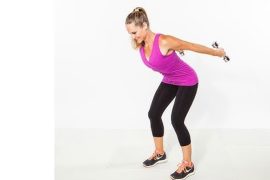As we embark on the journey of 2024, many individuals are fervently pursuing their New Year’s resolutions, ranging from fitness goals to adopting healthier habits. Amidst this pursuit, the revelation of achieving both physical and mental well-being through a simple mat and some gentle stretching unveils the transformative power of yoga pose. Serving as a serene and accessible avenue to kickstart one’s fitness journey, yoga pose offers a blissful fusion of physical exercise and mindfulness. Whether it’s committing to regular practice, enhancing flexibility, or cultivating a sense of inner peace, yoga pose provides a holistic approach to well-being that aligns seamlessly with the aspirations of the new year. So, for those seeking a harmonious commencement to their wellness endeavors, the practice of yoga pose emerges as an inviting and beneficial pathway.
1. Tree Pose (Vrikshasana):

Vrikshasana (Tree Pose) provides clear and concise instructions for practitioners. Here’s a breakdown of the steps:
- Derived from Sanskrit, “Vrikshasana” combines “vriksha,” meaning tree, and “asana,” meaning pose. This name reflects the posture’s resemblance to a tree standing tall and grounded.
- The pose is grounding and centering, aiding in aligning oneself and balancing energies.
- Gupta, a nutrition and fitness coach, emphasizes its benefits for improving balance and stability in the legs.
- Additionally, Vrikshasana is beneficial for pregnant women as it can ease pain and potentially facilitate a smoother delivery.
Steps to Perform Vrikshasana:
- Starting Position: Begin in Tadasana (Mountain Pose), ensuring a stable and grounded stance.
- Leg Lift and Placement: Lift your right leg, balancing on your left leg. Bend your right knee and place your right foot on the inner left thigh, toes pointing downward.
- Hand Position: Join your palms together in a prayer position at chest level. Advanced practitioners can extend their arms overhead.
- Hold and Breathe: Maintain the pose, taking deep breaths to help with balance and focus.
- Release and Return: Separate your palms as you lower your arms to chest level. Straighten your right leg and return to the starting position.
- Repeat on the Other Side: Perform the sequence on the opposite side, balancing on your right leg and placing your left foot on your inner right thigh.
Practicing Vrikshasana offers not only physical benefits such as improved balance and strength but also mental benefits like concentration and mindfulness.
Your detailed description of Tadasana (Mountain Pose) provides valuable insights into the asana’s benefits and step-by-step instructions. Let’s recap the information:
2. Tadasana (Mountain Pose):

- Also referred to as Mountain Pose, Tadasana serves as a foundational yoga pose that focuses on standing with awareness and alignment.
- Jiggyasa Gupta, a nutrition and fitness coach, highlights several benefits of Tadasana, including relief from sciatica pain, enhanced flexibility and balance, improved posture, and strengthened thigh, hip, and leg muscles.
Steps to Perform Tadasana:
- Weight Distribution: Ensure that your weight is evenly distributed on both feet, maintaining a slightly apart stance for stability.
- Inhale and Arm Movement: Inhale deeply, raising your arms above your head. Intertwine your fingers with palms facing up, extending through the arms.
- Exhale and Shoulder Alignment: Exhale as you roll your shoulders back and down the spine. Open your chest and straighten your posture while lifting your shoulders towards your ears.
- Tongue and Gaze: Keep your tongue relaxed without tension. Maintain a steady gaze with relaxed eyes to promote focus and mindfulness.
- Return to Standing: Relax and gently lower your arms, returning to your normal standing position with awareness and presence.
Incorporating Tadasana into your yoga pose practice offers a multitude of benefits for both the body and mind.
3. Cobra Pose (Bhujangasana):

Bhujangasana (Cobra Pose) provides a thorough guide for practitioners, including its name origin, benefits, and step-by-step instructions.
- Bhujangasana is a back-bending pose and is a fundamental part of the Surya Namaskar (Sun Salutation) sequence.
- The name is derived from Sanskrit, combining ‘bhujanga,’ meaning ‘cobra,’ and ‘asana,’ indicating ‘posture.’ The pose visually imitates a cobra with its hood gracefully raised.
- According to Gupta, a nutrition and fitness coach, Bhujangasana offers various benefits, including the correction of body posture, increased spinal flexibility and alignment, improved blood circulation, and enhanced lung capacity.
Steps to Perform Bhujangasana:
- Starting Position: Lie down flat on the floor on your stomach with your legs stretched back and toes on the floor.
- Hand Placement: Spread your palms on the floor under your shoulders, bringing the elbows close to the sides of your body.
- Pressing Feet and Thighs: Press the tops of your feet and thighs into the floor to establish a stable foundation.
- Inhale and Lift: Inhale, pressing your palms into the floor, and slowly straighten your arms.
- Chest Lift: Lift the chest off the floor up to your navel while keeping the pelvis on the floor.
- Buttocks Squeeze: Gently squeeze your buttocks while pushing your navel down.
Shoulder Engagement: Broaden your shoulder blades, engaging them to lift the chest forward.
- Hold and Breathe: Hold the pose for 15 to 30 seconds, inhaling and exhaling with awareness.
Release: Exhale and release back to the floor.
Incorporating Bhujangasana into your practice can be beneficial for enhancing the flexibility and strength of the spine, improving posture, and promoting overall well-being.
4. Baddha Konasana (Butterfly Pose):

- Baddha Konasana, also known as Butterfly Pose, offers a clear understanding of this seated yoga pose, including its benefits and step-by-step instructions.
- Baddha Konasana is a seated asana commonly practiced in hatha yoga that promotes flexibility and mobility in the hips, ankles, and knees.
- This pose can help relieve stiffness in the ankles and knees, improve hip mobility, and release emotional tension.
Steps to Perform Baddha Konasana:
- Starting Position: Sit on the floor with your legs extended straight in front of you, ensuring your spine is erect.
- Foot Placement: Bend your knees and bring the soles of your feet together, allowing your knees to drop to the sides.
- Positioning: Place your feet in front of your pelvis, maintaining a distance of approximately a fist’s width from your groin.
- Gentle Pressure: Take deep breaths as you gently press your thighs and knees toward the floor, applying gentle pressure to deepen the stretch.
- Flapping Motion: In a slow and controlled manner, begin to flap both your legs from the hips, resembling the wings of a butterfly. Continue this motion for approximately 60 seconds or as comfortable.
- Breathing Awareness: Maintain awareness of your breath throughout the pose, inhaling and exhaling deeply to facilitate relaxation and release.
5. Bitilasana Marjaryasana:
Indeed, the names Marjary and Bitila find their roots in the Sanskrit language, with “marjari” translating to “cat” and “bitila” translating to “cow.” In the context of yoga pose, these names are associated with two specific asanas, or poses, known as Cat Pose (Marjaryasana) and Cow Pose (Bitilasana). These poses are often combined in a flowing sequence to create a gentle and beneficial movement for the spine.
Bitilasana (Cow Pose):
- Start on all fours with your wrists positioned directly under your shoulders and knees beneath your hips.
- Inhale deeply as you lengthen from the hips to the armpits, simultaneously extending your fingers and pressing down firmly through your hands.
- Maintain straight arms as you lift the sides of your waist and point your feet straight back, creating a gentle backbend.
Marjaryasana (Cat Pose):
- Exhale and press your hands firmly into the floor, rounding your spine towards the ceiling like an arching cat. Tilt your pelvis down, scoop your tailbone, and lower your head to maximize the stretch along the spine.
- Inhale, reversing the spinal movement, and create a concave shape. Lift your head, tilt your pelvis upward, and arch your back to resemble a cow’s back.
- Repeat the flow between Bitilasana and Marjaryasana, syncing your breath with movement for 5-10 breaths or as comfortable.
Transition:
- After completing the sequence, push back into Child’s Pose, allowing yourself to relax and take a few deep breaths.
Benefits:
- Stretch and strengthen the spine and neck muscles.
- Massage and stimulate abdominal organs, promoting digestion and detoxification.
- Improve coordination and flexibility throughout the spine and shoulders.
This rhythmic flow between Bitilasana and Marjaryasana helps to warm up the spine, enhance flexibility, and cultivate a deeper connection between breath and movement. Regular practice can alleviate tension, enhance mobility, and bring a sense of grounding and relaxation.
Disclaimer:
The information contained in this article is for educational and informational purposes only and is not intended as a health advice. We would ask you to consult a qualified professional or medical expert to gain additional knowledge before you choose to consume any product or perform any exercise.









